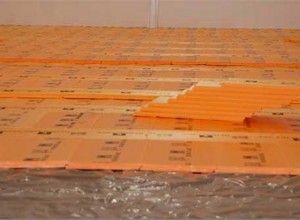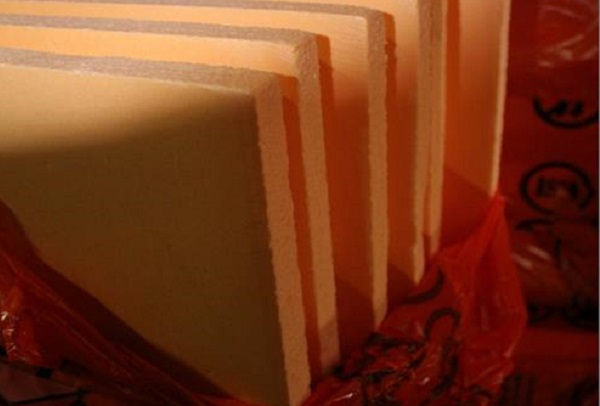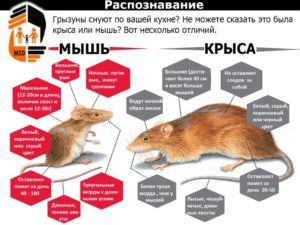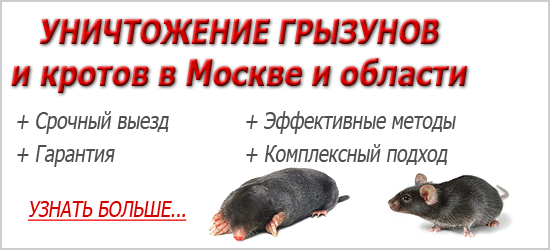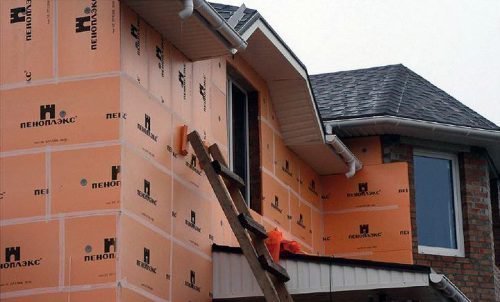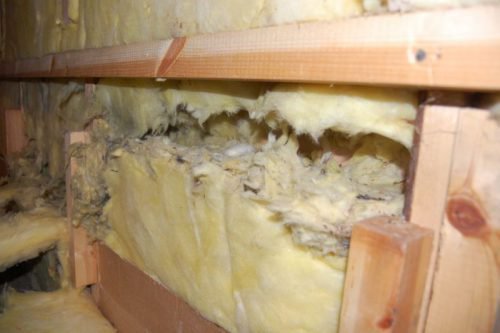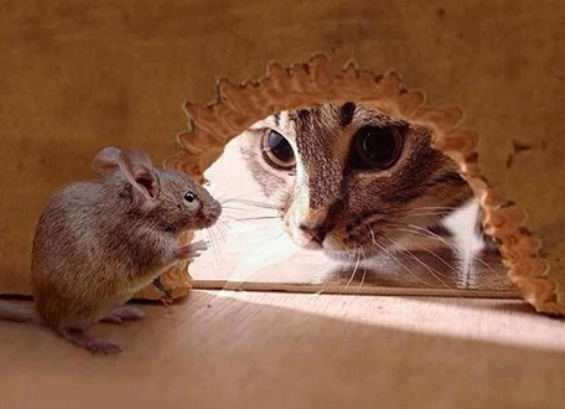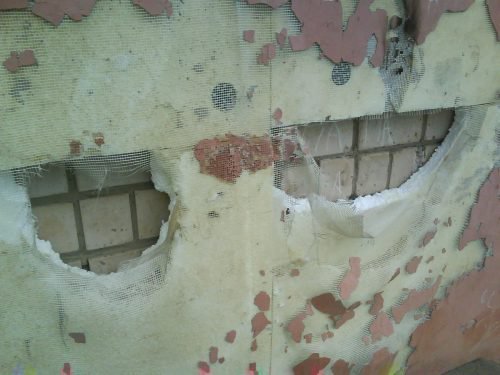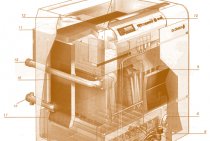Mice and penoplex
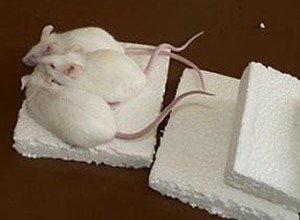
Animals tend to enter the premises in order to hide from the cold and dampness or in search of food. Mice are able to make tunnels in it to get to what they want, as a result of which the thermal insulation properties drop sharply. This is evidenced by the reviews affected by the actions of rodents.
Material Properties
Penoplex is laid on a concrete screed after waterproofing with polyethylene or roofing material
The technical characteristics of foam plastic make it attractive for use in the construction of low-rise structures and private and industrial construction:
- most importantly, this is a reduced thermal conductivity index, its indicator of 0.03 W * m * 0С can compete with any heater and remain the winner;
- increased resistance to transpiration (penetration) of moisture - only 2 cm of foam plastic in terms of vapor permeability correspond to roofing material;
- due to extrusion, the mass is homogeneous, therefore evenly distributed cells significantly increase its strength. Even at very high loads, its parameters are almost unchanged;
- high moisture resistance - the liquid is absorbed only in the places of cuts where the integrity of the cells is broken;
- Penoplex is not subject to rotting and decomposition, mold does not develop in it, which indicates a high biostability of this material.
The temperature regimes that allow the operation of penoplex range from -50 to +75 degrees Celsius, but for each type of penoplex, the temperature limits are indicated in the instructions.
You need to know: in order for the dimensions of the foam boards to remain unchanged, the temperature indicated in the product passport should be observed. With excessive heating, its characteristics can change.
Internal wall protection
Mice enter the house in the most unpredictable way. Tracking where they made moves can sometimes be difficult. Indoors, the animal is looking for a suitable place to equip its home. Most often under the floor, in the attic, in the walls, if there is suitable material.
Inside the house, rodents can be fought in any convenient way, except for poison. If the foam is treated with poison, the corpses of mice may appear between the walls, which will begin to decompose over time. It is very difficult to get out of there, the smell will be unbearable.
The inside of the walls can also be protected with a metal mesh, any dense material. Or soak the foam with denatonium benzoate. The substance does not pose a danger to humans, does not contain toxic ingredients, it just has a pronounced bitter taste. Mice will not gnaw on such material, the walls will be completely safe. The bitter substance will protect from the inside from all pests, including rodents, insects.
Many people are interested in the question - mice love polystyrene or mineral wool. There are several varieties of mineral wool, including ecowool. Rodents build passages in it, drag it into nests, like polystyrene. They try to avoid glass wool, because small particles of glass dig into the paws and irritate the skin.
Almost all synthetic insulation lends itself to mouse teeth, attracting the interest of pests. The most important protection is the high quality of construction and installation work.
Penoplex and security
Manufacturers and sellers constantly talk about the safety of the material, but is it true? Is penoplex harmful to health?
Many argue about the environmental friendliness of this material, explaining that even treated with flame retardant, it is subject to combustion.It is impossible to argue with this, since many of the objects surrounding us cannot withstand fire.
Penoplex flammability class is usually G4 or G3
Another thing is whether it is capable of igniting on its own or contributing to a fire. Here the question is unambiguous - no. But at the moment of ignition, it forms a lot of acrid smoke and releases toxic substances. However, its ignition occurs slowly, so until it catches fire, a lot of time will pass, and the fire can be put out in time.
Another drawback that has a negative impact on the human body is the destruction of the material that occurs under adverse operating conditions. Penoplex not only loses its properties, it oxidizes and begins to release toxins into the air. This happens when low-quality products are selected, or installation rules are violated.
Therefore, it is important to choose only material made in accordance with the technology, follow the rules during installation, and not use incompatible compounds. Only under these conditions will it fulfill its purpose without harm to humans.
Why do mice gnaw on styrofoam
In addition to all instincts, mice are characterized by exploratory behavior. Having met a new obstacle on their way, they will first try to try it on the tooth, and if they smell products behind the wall, they will quickly remove the obstacle. A group of scientists conducted 2 experiments. The starved mice had to eat polystyrene:
- The first experience showed that if there were food and water behind the foam wall, the rodents actively destroyed the material, but despite severe hunger, they were in no hurry to use it as food.
- In the second experiment, mice were offered several types of material. They preferred cardboard, paper and burlap, although they did not neglect polystyrene.
Is it worth using EPS

Mice and polyester
The use of non-natural materials is beneficial from an economic point of view. On the health side, an unfavorable atmosphere is created in the room. It has been observed that pests start less in a room with an excess of plastic and other synthetic materials.
The probability of penetration of mice, rats into the building is reduced from a theoretical point of view. You can use expanded polystyrene for home insulation. However, pests can gnaw through a layer of polystyrene, make moves in it, spoil the entire insulation structure. The expediency of using the material is in doubt.
Mice do not eat polystyrene, but easily gnaw through the entrances and exits in it. Already one through hole is enough for the room to lose heat, let the heat through. All efforts spent in vain, money thrown to the wind.
According to some reports, foam and its derivatives do not affect the health and well-being of mice. Rodents successfully build nests in polystyrene foam materials, live, breed. Others argue that EPS and mice are an incompatible concept. They can spoil everything, they won’t live there. Another question arises - is it possible to protect a layer of polystyrene insulation from mice.
Penoplex Wall
Fire retardants are present in its composition, which means that its resistance to combustion is increased. They are used in the installation of vertical structures, insulation of facades, external and internal walls, it is also allowed to insulate the facade of a house with foam plastic of this class.
But inside, insulation occurs only when it is impossible to do it outside for some reason. This type is especially good for plastering walls.
For indoor work, the thinnest slabs should be used, the heat level will increase, and work will be much easier
For indoor work, the thinnest plates should be used, the heat level will increase, and work will be much easier.
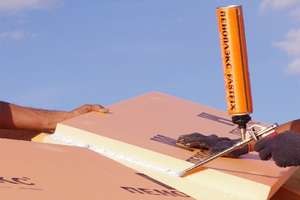
And in this article you can learn about the varieties of glue for penoplex.
What is the difference between a mouse and a rat
How is a mouse different from a rat?
- Rats are larger in size, with a longer tail and an elongated muzzle, they are also said to be smarter than mice and are their enemies, i.e. if possible, they can eat mice. Mice are smaller and less dangerous to humans than rats. Also, both of these species are omnivorous and spread various infections.
- rats differ from mice in large size, and even larger than rats - hamsters, rats are also smarter, can attack a person, and in general, in my opinion, rats are more unpleasant than mice. Although personally I'm afraid of both.
- A rat differs from a mouse primarily in size. Smarter animals. If mice easily fall into various mousetraps, then the rat still needs to be managed to catch (all hunting skills must be shown). Rats do more damage.
- According to my observations, the mouse is a small herbivorous rodent, and the rat is an omnivorous predator. In our village, I constantly fought rats, but I could never destroy them. They just migrated to another house. Then, when they started to get them there, they could come back to me. And I immediately determined that the rats had returned, not yet seeing any of them. After the rats left, the mice began to multiply rapidly. But as soon as the rats appeared, they immediately ate all the mice first. I guess it's a treat for them.
- But seriously, rats are much smarter than mice. Like mice, they are social animals, but their society has a more thoughtful structure compared to mice. A domestic rat is a very active and sociable animal. Knows his owners, his nickname, requires communication with his restless behavior at the sight of the owners.
How to keep styrofoam away from mice
If you do not prevent the invasion of rodents, the foam can turn into dust. Mice will actively and joyfully gnaw on it. And then the insulation layer of the house will be completely damaged. A favorite delicacy for mice are Finnish houses. Mice have been shown to gnaw through large areas of foam material in search of food. What to do so that they do not gnaw the foam?
There are some proven methods to help fight mice and prevent them from spoiling foam or other insulation:
Food supplies must be kept out of the reach of mice
The cleanliness of the home is very important.
When insulating a house, it is important to install the foam correctly. It is necessary to carefully putty it and sheathe it, using special materials for this.
In each case, appropriate materials are selected. It is important that there are no gaps. The absence of cracks is a sign of the absence of mice. Since mice are able to penetrate through the cracks. Effectively apply mounting foam, sealing holes.
It is useful at the level of penetration of mice to make a skin of metal that they are not able to gnaw through.
In the people, boric acid is used to fight mice.
Get a cat that is able to vigilantly guard the hearth.
Tighten the foam layer with a fine mesh. Get good protection against rodents.
Do not leave leftover food, garbage in the room and near the house. This is mouse bait.
When choosing a material for warming houses, give preference to denser types of polystyrene foam, which are difficult to gnaw through.
Install a device with ultrasound, able to scare away mice. The device is harmless to humans, but very sensitive to mice.
With the invasion of rodents, it is better to use the help of special disinfection services that will professionally and effectively treat the premises.
The most important thing in the fight against rodents is to keep your home clean and tidy. In places of unrest with heaps of garbage, rodents will definitely appear.
And it is very difficult to deal with the invasion of mice. Therefore, what is yours - do not give it to rodents. In clean, caring owners, mice will not start.If several individuals are seen, it is not difficult to get rid of them using only a mousetrap.
Why do mice gnaw on styrofoam
Styrofoam and polystyrene are soft, plastic materials. They are great for bedding as a heater not only for houses, but also for mouse nests. Even if the tailed tenants do not live in their thickness, they are used to create corridors that are convenient to move around.
Another reason why mice gnaw on foam plastic is laid down by nature itself. Like all rodents, their teeth grow constantly. Hence the need arises to sharpen them on any objects. A completely malleable building material is well suited for this purpose.

Not alien to mice and exploratory behavior, that is, the usual curiosity. When they encounter something new and incomprehensible, they try to try it in the most accessible way - by the tooth. And, finally, if the foam is an obstacle to entering a house or a pantry with food, then the gray bandits will quickly remove the barrier with their usual tool - their teeth.
Styrofoam or polystyrene foam - is there a difference?
In order to find out if mice show interest in polystyrene as a source of food, a group of scientists conducted a small experiment. The essence of the experiment was to force hungry mice to use polystyrene as food. The mice were in no hurry to eat such food, but actively destroyed it if they smelled food or water behind the polystyrene barrier.
The second experiment - mice were asked to make a choice between different materials, incl. and polystyrene. Mice did not ignore him, but still preferred paper, burlap, cardboard, etc.
A common question - do mice gnaw extruded polystyrene foam (foam, extruder) as actively as regular foam? As tests have shown, its pests also gnaw, although not so actively. The reason is the higher density of the material and the absence of rough surfaces.
Below is a comparison table - % damage to a material sample by day (the first digit is extruded polystyrene, the second is polystyrene.)
| View | Number of rodents, pcs | Animal condition | Degree of sample damage in % by day | |||||
| Age, months | Weight, g | 1 | 2 | 3 | 4 | 5 | ||
| house mouse | 5 | 4 | 16,5 | 10/50 | 20/60 | 0/80 | -/40 | -/70 |
| common vole | 5 | 3 | 14,5 | 30/40 | 5/50 | 10/30 | 5/60 | -/50 |
Are rodents useful?
Many rodents are very important in ecosystems and, as a result, are beneficial to humans. For example, they play a key role in maintaining the relationship between plants and fungi. Many fungi form mycorrhiza, symbiotic associations with plant roots that increase the plant's ability to extract nutrients and water from the soil a thousandfold. Small mammals carry fungal spores accumulated in their droppings to forest clearings, thus delivering fungi to where plant seeds germinate.
In South America, Africa and Asia, some large rodents are an important source of animal protein and are hunted or bred in captivity (eg guinea pigs in South America, cane rats in Africa). In the past, in Europe, regiments were grown for the same purpose.
Moreover:
- in many ecosystems, rodents are an important food resource for a huge number of predatory animals and birds;
- drugs are tested on rats and mice, they are used for scientific purposes;
- There are many pets among rodents. These are hamsters, guinea pigs, ornamental rats, chinchillas, rabbits, etc.;
- in some countries, rodents are even trained and taught to find mines in the fields (giant Gambian rats);
- various entertaining and educational shows with the participation of educated tame animals are also not uncommon.
As an afterword
What can you advise the owners of cottages and country houses, if they have a problem - mice gnaw on polystyrene foam (polystyrene foam). First, don't panic. A mink discovered in time should serve as a signal for immediate action.Check your home regularly for rodents, be vigilant. In this way, you can avoid serious problems and no less serious costs.
Secondly, if you have the opportunity, when building a house and insulating it, do not forget to cover a layer of expanded polystyrene with a protective fine-mesh mesh. Thus, you will protect the polystyrene foam not only from rodents, but also from birds, which can also cause damage.
Third, take the advice of seasoned homeowners and install an ultrasonic mouse and rat repeller. Believe that the costs will not be in vain and will pay for themselves with interest. The device is not so expensive, quite effective and does not need special maintenance.
Don't forget the cat too. There may even be several if you have a large farm. Our grandparents always kept a cat in the house and were pleased with the result. Cleanliness is not only a guarantee of health, but also a guarantee of your quiet life in your summer cottage. Mice eat what you throw at them, eat with appetite, eat a lot - don't forget about it!
In addition to eating thermal insulation material, they can infect you with some kind of infection (hemorrhagic fever for example). Therefore, after the extermination of mice, be sure to thoroughly disinfect. It is better not to do this yourself, as there is a risk of poisoning with chemicals. There are specialized companies dealing with deratization. They qualitatively destroy rodents and disinfect the territory.
About penoplex
There are many types of heaters, each with its own pros and cons. Penoplex is called extruded material. The extrusion method is simple. Under the influence of high temperature, under strong pressure, granular polystyrene foams, from which smooth plates are then made. This is a finely porous material in which cells isolated from each other are located. They are filled with air.
Why do many choose penoplex for the construction of a country house? The advantages of this material:
- It is inexpensive.
- Differs in the special durability and reliability.
- It has a low level of thermal conductivity, so penoplex is better than many heaters.
- It interferes with the penetration of moisture, only 2 cm of this insulation in terms of vapor permeability is the same as roofing material. But it absorbs moisture where the cut is, tk. at this point the cells lose their integrity.
- This material does not rot or decompose, there is no mold in it, i.e. it is biostable. But, despite this, it is highly environmentally friendly, although some disagree with this statement. If there is a fire and the material catches fire, then harmful substances are released. But penoplex cannot ignite on its own. It is easy to cut, you can install it, not paying attention to weather conditions.
- It serves, taking into account various influences, fifty years. But studies have been conducted in which the material was frozen and then thawed. Even in such harsh conditions, he withstood, and confirmed his warranty period with a margin.
- Does not dissolve, does not change shape when exposed to alcohol-based paints, chlorine, cement mortar, etc.
In order for these useful properties to be preserved, it is important to buy quality products and install them correctly. If these conditions are not met, it loses its properties, oxidizes and even releases toxins.
Penoplex regularly serves the owner of the house for 50 years or more
There are several types of penoplex, which differ from each other in various characteristics. There is Penoplex Foundation, with special strength. Penoplex wall is made with flame retardants, so this material will not immediately ignite. They are rarely insulated inside, if it is difficult to do it outside. If you work with it indoors, choose thinner plates to make it easier to work.There is also Penoplex Roofing, which can withstand heavy loads. Such a roof will last a long time, even if it is a flat version, and then a flower garden was laid out on it. There is also the universal Penoplex Comfort, which is used everywhere.
Foam Protection
To prevent the foam from turning into dust, it is necessary to prevent the appearance of mice. To do this, you must follow certain rules:
- You can't leave food on the table. It should be in places inaccessible to mice.
- Periodically, general cleaning of any room should be carried out. Basements, attics, all corners are cleared of debris and rubbish.
- Mice will be afraid to attack the house if they smell a cat. Therefore, it is recommended to purchase a cat.
- Installation of foam must be carried out according to the rules. All cracks in the walls are sealed with mounting foam, since it is through them that rodents enter the house. Polystyrene is puttied, then sheathing is applied from special materials.
- Rodents will not be able to gnaw through metal, so it is recommended that the foam be covered with a fine mesh. The size of the cells should not exceed 8×8 mm. In this case, the grid is laid out to a height of up to 30 cm. Instead of a grid, you can use a solid facing material or dense insulation.
- During the construction of the house, a strip foundation should be laid. The contour, which is formed during its laying of reinforced concrete beams, is covered around the circumference with broken glass. Through it, mice will not be able to enter the room.
- You can pour boric acid around the perimeter of the house, around the holes. It is a poison that destroys small pests.
- Construction stores sell foam boards treated with rodenticides. Thanks to this chemical, mice refuse to chew on them. But over time, the substance breaks down or evaporates, the insulation becomes harmless, being attacked by rodents.
- You can solve the problem with mice with the help of an ultrasonic repeller, which is installed indoors. The sound waves emanating from the device are perceived by rodents as noise. They experience severe discomfort, leave the house in search of better living conditions. Man and animals do not hear this sound.
- Discovered minks and tunnels should be covered with a mixture made of broken glass and concrete.
Models of ultrasonic repellers
There are many devices on sale with different ranges, adjustable power of the emitted signal. There are models equipped with LEDs. Popular Models:
- Tornado 400. The range of the device is capable of covering an area of up to 400 m². Small pests do not have time to adapt to the noise, since the reproduced sound frequency is constantly changing, while acting continuously.
- GRAD A 1000 PRO. The device has 4 modes of operation, so it repels not only mice, but also other small pests. The impact radius covers an area up to 1000 m². The efficiency of the device at close range is increased several times thanks to 6 bright built-in LEDs. The signal strength can be adjusted independently.
- A compact device that combines 2 types of impact: acoustic and electromagnetic. When the device is started, a force field is formed that spreads throughout the house through electrical wires.
Poison baits
Ready-made poisonous baits will help to quickly exterminate mice, rats. To avoid unpleasant cadaveric odors from their decaying bodies, it is necessary to choose drugs with mummifying properties. These drugs include baits called "Goliath", "Storm". According to consumer reviews, kit No. 3, called “Down with uninvited guests”, has proven itself well. It includes:
- flavored toxic substances in the amount of 5 pieces of 100 g;
- bait house;
- latex gloves.
With this kit, you can exterminate all pests in the house and on the adjacent territory of about 300 m².
Special disinfection services will help you quickly get rid of rodents if all methods have been tried, but did not bring the desired result. Specialists will treat the house with modern chemicals and recommend how to protect the foam from mice, rats and other pests.
Rodents and penoplex
Do mice eat this material? These rodents, like any living creatures, eat only what is necessary for the body, i.e. various nutrients, vitamins, minerals, etc. Penoplex does not contain these beneficial substances, so mice do not eat it.
Why mice gnaw foam
But this does not mean that your garden houses are protected. Yes, mice do not eat penoplex for food, but they still gnaw it to build tunnels. They need access to a living space where it is warm and there is food. If the mice plan to get inside, they will not use the door for this, but will gnaw through tunnels in the walls, including in the insulation. This material lends itself easily to their sharp teeth.
Mice gnaw on almost everything, and in the case of penoplex, they don’t have to try very hard, because. it is a soft material with a porous composition that lends itself easily. It is also bad that by destroying the integrity of the insulation, mice worsen its thermal insulation properties.
Mice love to gnaw their way through soft insulation.
Protection methods
How to protect your home from rodents, how to prevent damage to the insulation? If this is a country house, then try to make it unattractive to rodents. Mice run to where there is a lot of food. Therefore, remove all crumbs, all supplies, take them with you or hide them in jars where they will not climb. But there are other ways to protect:
- Buy hard boards that mice can't chew through.
- Do not be too lazy to place a metal mesh or a sheet of tin outside that the mice cannot overcome.
- Lead a constant fight with rodents, get a cat that will drive them out of the house.
- Another way to protect is to paint the insulation.
Or ditch the foam and use material that mice don't chew on. Now there are many thermal insulation materials that meet these requirements. Rodents do not live in expanded clay, but they will drown in sand or gravel insulation. Mice will not be able to gnaw through expanded clay, so they can insulate basements, walls, floors, etc. Or get foam glass, which is also not favored by mice.
Before you start building a house, consider all the details. Where mice are found, and the fight against them does not bring results (neighbors have all the conditions for the reproduction of rodents), it is worth building houses with heaters that mice do not gnaw. In other cases, it is necessary to use methods of protection and constantly fight rodents.
How to keep mice out of your home
Getting rid of them is a whole science. But, if you get down to business competently, you can free your house from guests quickly enough. There are many methods for this.
- It is not recommended to leave food and prepared food in open accessible places. It is necessary to store food only in the refrigerator, cabinets, closed plastic or metal containers. They must be inaccessible to small mammals.
- It is required to constantly maintain cleanliness and order inside the house and on its territory. Get rid of waste, crumbs, and everything that can be edible for rodents in time.
- Do not leave large holes in walls and floors. Get rid of cracks in a timely manner with mounting foam. Large holes should be clogged with rags, covered over.
- You can get a cat. But here it will be necessary to responsibly approach the choice of breed. Often well-fed creatures with a rich pedigree are simply not physically able to catch up with a dexterous mouse. Here, ordinary cats are more suitable.
Insulation protection from rodents
Qualitatively performed work on the insulation of the facade should not contain gaps, flaws.In practice, it turns out that if there are omissions, mice are able to get to the extruded polystyrene foam.

Mice gnaw through insulation
To prevent the invasion of rodents, you need to take care of this during installation work. At the bottom of the wall, expanded polystyrene should be protected by a plinth strip, reinforcing mesh. It is enough to ensure the integrity of the structure in the lower part of the building to prevent the penetration of pests.
If the moment is missed and mice live in the wall, you must:
- get rid of them by any known methods;
- make sure there are no rodents;
- for complete certainty, tear off the bottom of the polystyrene foam;
- restore the damaged part, restore the integrity of the structure.
Mice penetrate the smallest cracks, narrow gaps. When performing insulation work, it is necessary to ensure that all parts of the structure fit snugly, adjoin each other
Pay special attention to the bottom of the building
Mice annoy with their presence in private houses and apartments. They live in the basements, upper floors of the building, settle on the ceiling. Nothing is impossible for them. Do not assume that pests will not climb to the upper floors. Care must be taken to protect the expanded polystyrene during its installation.
What attracts mice in the house
To understand why mice gnaw on foam, you need to figure out what attracts them so much to the human house?
The most important goal of both mice and rats is to find food. They won't gnaw on anything for nothing to do. To get food, mice will gnaw through not only polystyrene, but also mineral wool or other insulating material. Mice always move in groups. Therefore, if they have chosen some kind of dwelling, their invasion is quite possible. Rats work differently. First they send a "scout". If he did not see the danger, then the rest of the individuals are already on their way.
Therefore, upon seeing a rodent, a person should take quick action. Where there is one individual, a whole family or horde may subsequently appear.
It is important to take into account the mouse instinct - the desire to stockpile. Therefore, in insulated walls, rodents can make their food warehouse
They don't eat everything at once. After a while, the food rots. There is a bad smell in the house. The most unpleasant thing is the dead individuals. This will happen if a piece of thermal insulation material enters the mouse stomach.
Rodents gnaw huge holes in foam
Table of ways to prevent rodent attacks
| Metal grid | It is the most reliable option to protect the building from rats and mice. For this, a fine-mesh steel mesh with a galvanized coating is best suited. The height of protection along the base varies from one meter or more. The mesh can also be used to protect the thermal insulation of the floor. |
| Boric acid | This substance can process chipboard. Mice and rats do not tolerate boric acid, which has long been successfully used by manufacturers of building materials. |
| Folk remedies | At the construction stage, heat-insulating material can be treated with tobacco dust, slag, ash, sprigs of pine, dry wormwood or mint can be put. Rodents categorically do not tolerate the smell of all these products. Hot pepper also works well, the pods of which should be laid along the walls. Experienced builders are advised to process materials with a solution of borax or lime. |
| Ultrasonic repellers | This is a fairly effective means of dealing with rats and mice, although it also has certain disadvantages. The device is applicable if the thermal protection of an already built house has been attacked by pests. |
| Biological weapons | Sometimes the most ancient method works in our case. Mice are afraid of cats at the gene level and leave. Thus, this animal can protect not only your food supplies and peace from the invasion of rodents, but also thermal insulation, and with it nerves and finances. |
